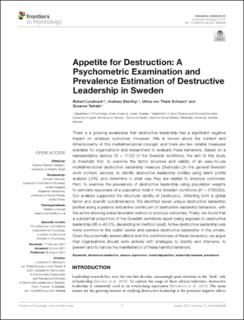Appetite for Destruction: A Psychometric Examination and Prevalence Estimation of Destructive Leadership in Sweden
Peer reviewed, Journal article
Published version
Permanent lenke
https://hdl.handle.net/11250/2988881Utgivelsesdato
2021Metadata
Vis full innførselSamlinger
Originalversjon
Lundmark, R., Stenling, A., von Thiele Schwarz, U.,& Tafvelin, S. (2021) Appetite for Destruction: A Psychometric Examination and Prevalence Estimation of Destructive Leadership in Sweden. Frontiers in Psychology, 12, 17. https://doi.org/10.3389/fpsyg.2021.668838Sammendrag
There is a growing awareness that destructive leadership has a significant negative impact on employe outcomes. However, little is known about the content and dimensionality of this multidimensional concept, and there are few reliable measures available for organizations and researchers to evaluate these behaviors. Based on a representative sample (N = 1132) of the Swedish workforce, the aim of this study is threefold: first, to examine the factor structure and validity of an easy-to-use multidimensional destructive leadership measure (Destrudo-L)in the general Swedish work context; second, to identify destructive leadership profiles using latent profile analysis (LPA), and determine in what way they are related to employe outcomes; third, to examine the prevalence of destructive leadership using population weights to estimate responses of a population total in the Swedish workforce (N = 3100282). Our analysis supported the structural validity of Destrudo-L, reflecting both a global factor and specific subdimensions. We identified seven unique destructive leadership profiles along a passive and active continuum of destructive leadership behaviors, with the active showing a less favorable relation to employe outcomes. Finally, we found that a substantial proportion of the Swedish workforce report being exposed to destructive leadership (36.4–43.5%, depending on method used). Active destructive leadership was more common in the public sector and passive destructive leadership in the private. Given the potentially severe effects and the commonness of these behaviors, we argue that organizations should work actively with strategies to identify and intervene, to prevent and to handle the manifestation of these harmful behaviors.

